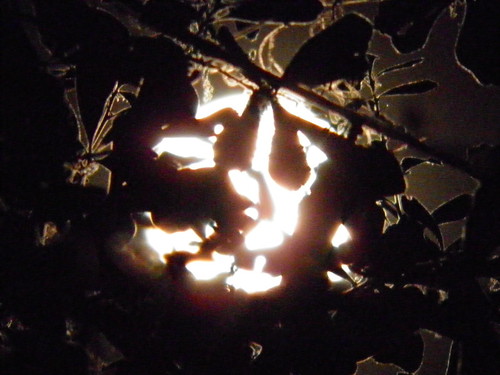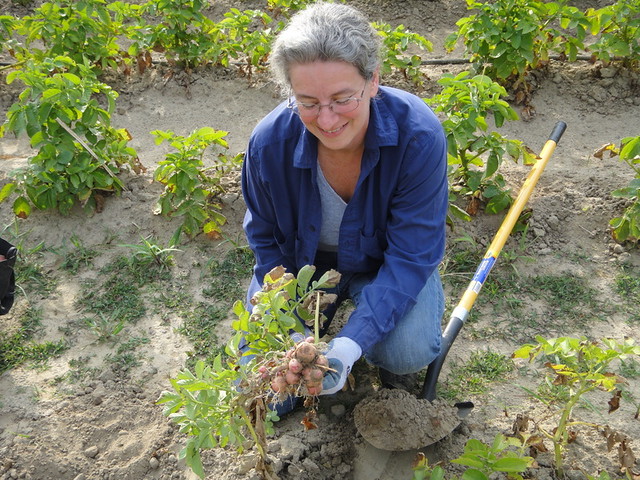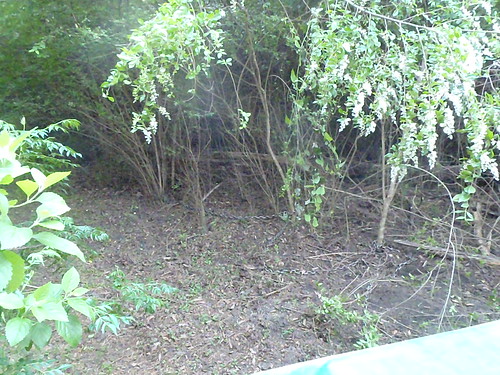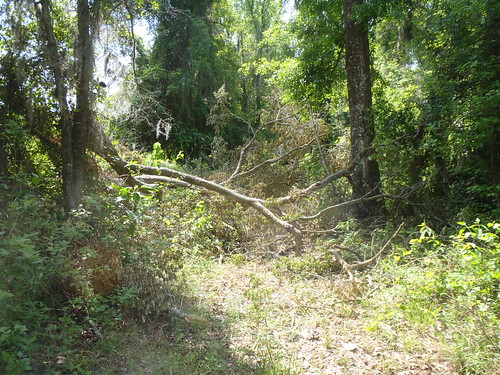Moon mandala: Continue reading
Category Archives: Plants
Dirt igloo door (sweet potato curing mound)
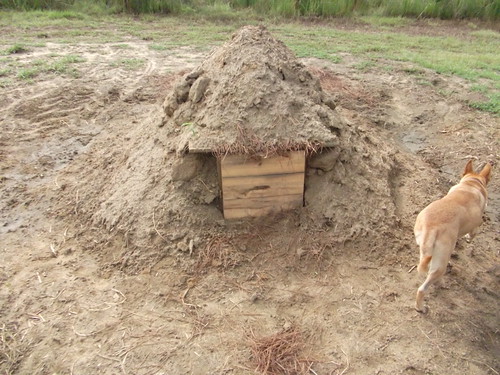
Pictures of sweet potato curing teepee
by John S. Quarterman, 8 September 2011,
Okra Paradise Farms, Lowndes County, Georgia.
Yellow Dog was busy tracking something, so didn’t stay to pose.
The door is on the north side. It’s six pieces of 2×6″ pine, each 18″ long, three vertical and three horizontal, screwed together, and set inside the doorposts. Here’s a closeup: Continue reading
Banking sweet potatoes
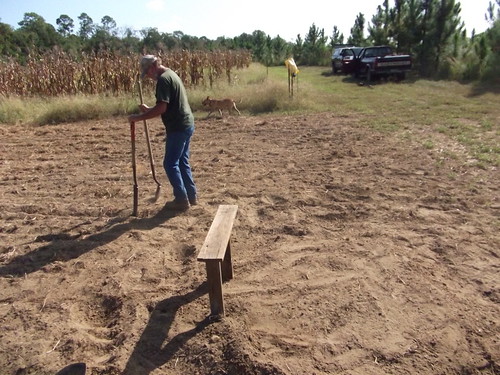
Terry Davis and John S. Quarterman banking sweet potatoes at
Okra Paradise Farms.
Pictures by John S. Quarterman, Lowndes County, Georgia, 25 August 2011.
Watch the slideshow and see:
-jsq
Elsie Quarterman’s Tennessee Coneflower taken off endangered species list
 WSMV in Nashville reports that
the Tennessee purple coneflower, which grows only in cedar glades,
and only in three counties in the world,
is being taken off the endangered species list:
WSMV in Nashville reports that
the Tennessee purple coneflower, which grows only in cedar glades,
and only in three counties in the world,
is being taken off the endangered species list:
 Less than one percent of endangered species ever get taken off the list.
The
Tennessean reports:
Less than one percent of endangered species ever get taken off the list.
The
Tennessean reports:
The U.S. Fish and Wildlife Service plans to officially remove the wildflower by Sept. 2, from its list of plants that are near extinction.“The Tennessee coneflower’s recovery is an example of what can be achieved through the combined efforts of dedicated partners,” said Cindy Dohner, the Service’s Southeast Regional Director, in an emailed announcement.
Echinacea tennesseensis was thought extinct until Dr. Elsie Quarterman rediscovered it in 1969 in the cedar glades which are her academic specialty. She was 59 then.
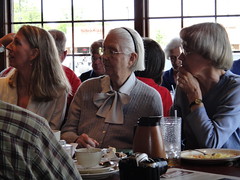 Now she is 100, and still being honored
by her students
and by her state.
Now she is 100, and still being honored
by her students
and by her state.
Aunt Elsie
 was born in Valdosta and played basketball for Hahira High School,
before she started her very long career in botany and plant ecology.
was born in Valdosta and played basketball for Hahira High School,
before she started her very long career in botany and plant ecology.
As aye, Elsie!
-jsq
PS: This post owed to Patrick Quarterman.
Don’t tell Terry! (Sweet potatoes are ready)
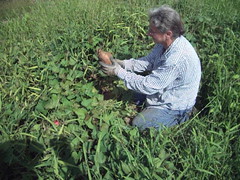 “Look at that!”
We planted them back in March.
“Look at that!”
We planted them back in March.
Here’s Part 1 of 3:
Sweet potato eruption! Part 1 of 3:
Digging Potatoes, Okra Paradise Farms (OPF),
Lowndes County, Georgia, 24 July 2011.
Videos by John S. Quarterman for Okra Paradise Farms (OPF).
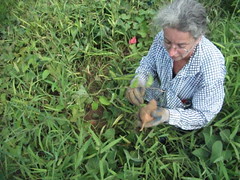 “Like an earthquake!”
When they get ready, they crack the ground.
“Like an earthquake!”
When they get ready, they crack the ground.
Here’s Part 2 of 3: Continue reading
Gretchen digging lots of potatoes
 Gretchen digging the potatoes she’s selling today at
Downtown Valdosta Farm Days.
Gretchen digging the potatoes she’s selling today at
Downtown Valdosta Farm Days.
Look at the roots on that thing!
Hundreds of pounds of potatoes: Continue reading
11 year old is onto Monsanto and how to fix the food system
His personal goal:Conventional farmers use chemical fertilizers made from fossil fuels. Then they mess with the dirt to make the plants grow. They do this because they’ve stripped the soil from all nutrients from growing the same crop over and over again. Next more harmful chemicals are sprayed on fruits and vegetables. Like pesticides and herbicides to kill weeds and bugs. When it rains, these chemicals seep into the ground, or rise into our waterways, poisoning our water, too.
A while back, I wanted to be an NFL footall player.He’s got a turn of phrase:
I decided I’d rather be an organic farmer instead.
[applause]
That way I can have a greater impact on the world.
We can either pay the farmer, or we can pay the hospital.
-jsq
At 100, Elsie Quarterman attends her Cedar Glade Wildflower Festival
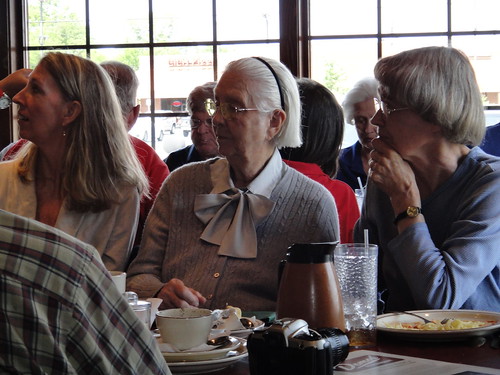
Kim Cleary Sadler,
Assistant Professor of Biology at Middle Tennessee State University
and co-Director of the
Center for Cedar Glade Studies.
(Student of
Thomas “Tom” Ellsworth Hemmerly, who was teaching and couldn’t come.)
Dr. Elsie Quarterman, Professor Emerita of Plant Ecology, Vanderbilt University
Carol C. Baskin, Professor of Biology, University of Kentucky
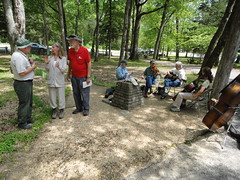 There were classes, botany walks, owl hoots, and musicians.
Here’s the schedule.
It was sunny this year,
unlike last year’s great flood.
Next year, you should come!
Get out of town, take a walk in the glades.
There were classes, botany walks, owl hoots, and musicians.
Here’s the schedule.
It was sunny this year,
unlike last year’s great flood.
Next year, you should come!
Get out of town, take a walk in the glades.
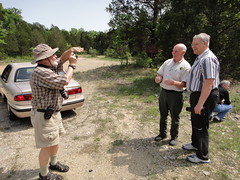 Elsie got a guided tour, with
Tennessee State Naturalist Emeritus Mack Pritchard
and his successor Randy Hedgepath.
Here they are with Elsie’s nephew Patrick Quarterman,
while Gretchen Quarterman photographs a glade.
Elsie got a guided tour, with
Tennessee State Naturalist Emeritus Mack Pritchard
and his successor Randy Hedgepath.
Here they are with Elsie’s nephew Patrick Quarterman,
while Gretchen Quarterman photographs a glade.
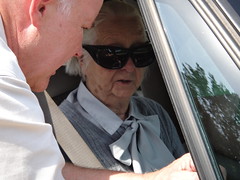 Here
State Naturalist Randy Hedgepath
consults with Dr. Quarterman about identification of a cedar glade plant.
Here
State Naturalist Randy Hedgepath
consults with Dr. Quarterman about identification of a cedar glade plant.
Elsie got out of the car to look at this one with Randy and Ann Quarterman: Continue reading
Privet fishing
First, hook some privet:
Then pull with tractor: Continue reading
Good thing I bought oil for the chain saw
Good thing I bought oil for the chain saw: Continue reading
